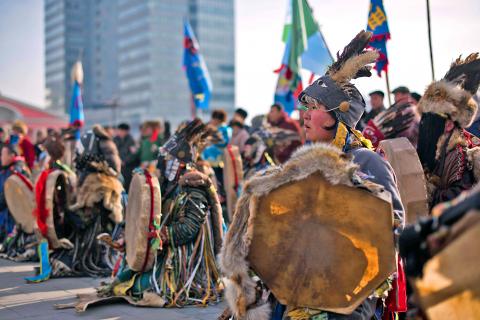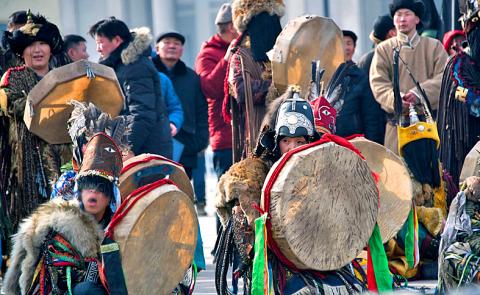Chanting prayers to Tenger, the all-knowing holy sky, Mongolian shamans in fur and feather headdresses protested against a Canadian mining project they say threatens ancient grave sites.
“It’s for our love for Mongolia, to protect our resources and territory,” said Tseyen-Oidoviin Sarantuya, who traveled more than 1,000km to demonstrate in Ulan Bator’s main square against the venture.
“I want people to know that Mongolia should remain Mongolian,” she said.

Photo: AFP
Beneath Mongolia’s expansive, largely empty steppes lie coal, copper, gold, iron ore and other minerals whose worth is estimated at more than US$1 trillion — wealth that could transform the lives of its 3 million inhabitants.
However, efforts to extract it have tottered in the face of incessant internal fighting over how much control and profit foreign companies should be allowed, and deep-rooted suspicions of outsiders.
Several naturally endowed countries — such as Venezuela, Myanmar and Nigeria — are regarded as having failed through corruption, bad governance or economic mismanagement to fully realize or effectively distribute the benefits of their bounties.

Photo: AFP
“Mongolia already faces the resource curse. It is reality now,” said Gantumuriin Uyanga, a member of the State Great Hural Parliament.
Her Mongolian National Democratic Party is part of the ruling coalition, but she said spiritual appeals illustrated authorities’ failure to spread the wealth.
“It seems to me truly unfortunate that people are asking help from the sky because of the poor governance in Mongolia,” she said.
Four years ago, the country led the world in economic growth at 17.5 percent, thanks to a minerals boom exemplified by the vast Oyu Tolgoi copper and gold mine in the Gobi desert, controlled by Anglo-Australian resources giant Rio Tinto.
However, rising resource nationalism and an increasingly stringent business environment have dampened investor enthusiasm, while the global commodity bust makes exploiting them less profitable.
Last year, foreign direct investment into the landlocked country plummeted 74 percent, Mongolian central bank data shows, and economic growth dropped to 7.8 percent.
The Asian Development Bank forecasts expansion will plunge by more than half this year, to just 3 percent.
University of British Columbia Mongolia expert Julian Dierkes said the country was still finding its way in the capricious world of international finance and was simultaneously “the object of desire and scorn for global capitalism.”
Now authorities are trying to break the logjam.
In February, Mongolia’s president pardoned three foreign former mining executives who had been jailed for tax evasion in a case that spooked investors.
Earlier this month, Mongolian Prime Minister Chimediin Saikhanbileg — who can reportedly bench-press 175kg — announced the government and Rio Tinto had agreed “in principle” to go ahead with Oyu Tolgoi’s stalled second phase, saying that making “historic decisions” was his duty.
Rio Tinto chief executive Sam Walsh told the company’s annual meeting last week discussions were continuing.
Ulan Bator has a national dilemma to contend with.
The proud homeland of pan-Asian conqueror Genghis Khan, in more recent centuries, Mongolia has frequently been a geopolitical pawn in the power plays of huge neighbors China and Russia, both of which have dominated it in turn.
Sodnomiin Tsetsgee, a kindergarten teacher expecting her first child, was among the many who boycotted a controversial text message referendum that backed stalled foreign resources investment ahead of the prime minister’s Oyu Tolgoi announcement.
“We should use our resources for ourselves,” she said. “It’s not good that only foreigners benefit from them.”
Mongolia’s nomadic heritage, traditional animistic beliefs and nearly seven decades of communism have given it an enduring sense of the land as common wealth — private land ownership was only constitutionally recognized after the country’s 1990 democratization.
Myagmarjaviin Enkhzaya, vice president of the Institute of Mongol National Shamans, took part in the Ulan Bator protest and says Toronto-based Centerra Gold’s plan would harm culturally important graves.
The company says the burial sites’ locations are known and it will not interfere with them.
However, Enkhzaya said: “We want people to understand that while you sleep, greedy people will be exploiting Mongolian natural resources, as well as the mountains we worship. There will be no land to inherit in future because corrupt politicians are selling it away.”
At the same time, Mongolia’s US$1.3 trillion in mineral riches are a treasure trove in a country with a GDP of just US$12 billion.
The result can be conflicting attitudes.
Some shamans have turned down lucrative jobs with mining companies out of spiritual concerns, University of Washington researcher Amalia Rubin said.
“There’s very much this internal argument between wanting Mongolia to develop and wanting Mongolian people to get the benefits of economic development, with the idea of propitiating the earth spirits and also following traditional Mongolian customs,” she said.

The US dollar was trading at NT$29.7 at 10am today on the Taipei Foreign Exchange, as the New Taiwan dollar gained NT$1.364 from the previous close last week. The NT dollar continued to rise today, after surging 3.07 percent on Friday. After opening at NT$30.91, the NT dollar gained more than NT$1 in just 15 minutes, briefly passing the NT$30 mark. Before the US Department of the Treasury's semi-annual currency report came out, expectations that the NT dollar would keep rising were already building. The NT dollar on Friday closed at NT$31.064, up by NT$0.953 — a 3.07 percent single-day gain. Today,

‘SHORT TERM’: The local currency would likely remain strong in the near term, driven by anticipated US trade pressure, capital inflows and expectations of a US Fed rate cut The US dollar is expected to fall below NT$30 in the near term, as traders anticipate increased pressure from Washington for Taiwan to allow the New Taiwan dollar to appreciate, Cathay United Bank (國泰世華銀行) chief economist Lin Chi-chao (林啟超) said. Following a sharp drop in the greenback against the NT dollar on Friday, Lin told the Central News Agency that the local currency is likely to remain strong in the short term, driven in part by market psychology surrounding anticipated US policy pressure. On Friday, the US dollar fell NT$0.953, or 3.07 percent, closing at NT$31.064 — its lowest level since Jan.

Hong Kong authorities ramped up sales of the local dollar as the greenback’s slide threatened the foreign-exchange peg. The Hong Kong Monetary Authority (HKMA) sold a record HK$60.5 billion (US$7.8 billion) of the city’s currency, according to an alert sent on its Bloomberg page yesterday in Asia, after it tested the upper end of its trading band. That added to the HK$56.1 billion of sales versus the greenback since Friday. The rapid intervention signals efforts from the city’s authorities to limit the local currency’s moves within its HK$7.75 to HK$7.85 per US dollar trading band. Heavy sales of the local dollar by

The Financial Supervisory Commission (FSC) yesterday met with some of the nation’s largest insurance companies as a skyrocketing New Taiwan dollar piles pressure on their hundreds of billions of dollars in US bond investments. The commission has asked some life insurance firms, among the biggest Asian holders of US debt, to discuss how the rapidly strengthening NT dollar has impacted their operations, people familiar with the matter said. The meeting took place as the NT dollar jumped as much as 5 percent yesterday, its biggest intraday gain in more than three decades. The local currency surged as exporters rushed to